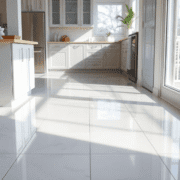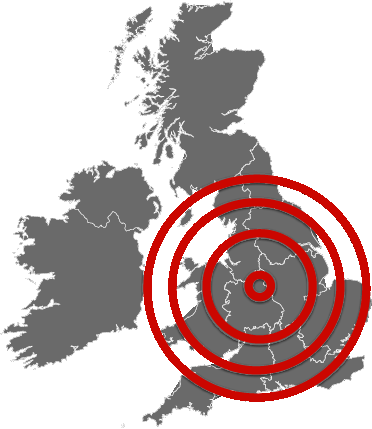How To Clean Ceramic Tile
Ceramic tile floors are a perfect combination of style and practicality in modern homes. They can be found in many kitchens, bathrooms, and living areas, offering both durability and beauty. The natural charm of ceramic tiles, along with their resistance to water and long-lasting qualities, makes them a popular choice for homeowners throughout the UK.
Regular cleaning of ceramic tiles isn’t just about keeping them looking nice – it’s an investment in your home’s future.
Clean tiles:
- Preserve their original shine and colour
- Prevent the growth of harmful bacteria and mould
- Protect the integrity of grout lines
- Extend the lifespan of your flooring
- Maintain healthy indoor air quality
Your ceramic tile floors face daily challenges from foot traffic, spills, and environmental factors. Without proper care, these beautiful surfaces can lose their shine, develop stubborn stains, and even suffer permanent damage. A well-maintained ceramic tile floor can last for decades, adding value to your property while providing a hygienic and attractive living space.
The good news? Cleaning ceramic tiles doesn’t require complex techniques or expensive products. With the right approach and regular maintenance, you can keep your ceramic floors looking as stunning as the day they were installed.
Preparation Before Cleaning
Proper preparation creates the foundation for effective ceramic tile cleaning. A well-planned cleaning session saves time and ensures better results.
Essential Pre-cleaning Steps:
- Clear the Space
- Remove all furniture, rugs, and movable objects from the tiled area
- Place furniture pads under heavy items that can’t be moved
- Store delicate items safely away from the cleaning zone
- Initial Surface Assessment
- Check for loose or damaged tiles
- Identify heavily stained areas
- Note any sensitive areas requiring special attention
- Basic Surface Cleaning
- Sweep or vacuum the entire floor thoroughly
- Remove loose dirt and debris from corners and edges
- Pay special attention to high-traffic areas
- Clean cobwebs from skirting boards and adjacent walls
- Tool and Supply Organisation
- Gather all cleaning supplies within easy reach
- Prepare clean cloths and mops
- Fill buckets with appropriate cleaning solutions
- Keep safety equipment ready (gloves, knee pads)
- Area Protection
- Cover adjacent carpets or wooden floors with protective sheeting to avoid any potential damage during the cleaning process. If you’re unsure about how to protect your hardwood floors, this guide on refinishing hardwood floors can provide useful tips.
- Protect skirting boards with masking tape
- Ensure proper ventilation in the cleaning area
- Place warning signs for wet floors in busy areas to prevent accidents
These preparation steps create ideal conditions for thorough tile cleaning and help prevent potential damage to surrounding surfaces. If you come across any levelling screed on your quarry tiles during your initial surface assessment, you may need to remove it professionally, as this could require specialised knowledge and tools.
Choosing the Right Cleaning Solution
Selecting an appropriate cleaning solution for your ceramic tiles makes the difference between maintaining their lustre and potentially damaging their surface. The right cleaner preserves the tile’s protective coating whilst effectively removing dirt and grime.
Store-Bought Solutions
- pH-neutral tile cleaners
- Specialised ceramic tile cleaning products
- Multi-surface floor cleaners (check compatibility)
Effective Homemade Solutions
- Warm water + mild dish soap (2 tablespoons per bucket)
- White vinegar solution (1 part vinegar to 4 parts water)
- Baking soda paste for tough spots
What to Avoid
- Bleach-based products
- Ammonia cleaners
- Oil-based detergents
- Harsh abrasive cleaners
A simple test helps determine if a cleaning solution is safe: Apply a small amount to an inconspicuous area and wait 24 hours. If no discolouration or damage occurs, the solution is safe to use.
Pro Tip: Always dilute cleaning solutions according to manufacturer instructions. Concentrated cleaners can leave residue that attracts dirt and dulls your tile’s appearance.
For regular maintenance, warm water mixed with a mild detergent proves sufficient. Save stronger cleaning solutions for periodic deep cleaning sessions or stubborn stains. Remember to avoid cleaning products containing dyes or colours that might stain your grout.
Step-by-Step Cleaning Process
Let’s dive into the essential steps for achieving spotless ceramic tile floors:
1. Initial Sweep
- Use a soft-bristled broom to remove loose dirt and debris
- Pay special attention to corners and edges where dust collects
2. Vacuum
- Run a vacuum cleaner with a soft brush attachment
- Remove any remaining loose particles from grout lines
3. Prepare Your Mop
- Use a clean, non-abrasive mop head
- Dampen the mop – avoid oversaturating the floor
- Wring out excess water to prevent water damage
4. Mopping Technique
- Work in small sections (2×2 metre areas)
- Use figure-eight motions for thorough coverage
- Change cleaning solution when it becomes visibly dirty
5. Rinse Thoroughly
- Fill a bucket with clean, warm water
- Mop the entire floor to remove cleaning solution residue
- Replace rinse water as needed
6. Drying Process
- Use a clean, dry microfibre cloth or towel
- Wipe in straight lines to avoid streaks
- Allow natural air drying for remaining moisture
Pro tip: For optimal results, avoid walking on freshly cleaned floors until completely dry
Remember to clean your tools after use and store them properly for future cleaning sessions. Regular maintenance with these steps helps preserve your ceramic tile’s appearance and extends its lifespan.
Stain Removal Techniques
Stubborn stains on ceramic tiles require specific treatment methods based on the type of stain. Here’s how to tackle common staining issues:
Food and Beverage Stains
- Mix baking soda with water to create a paste
- Apply directly to the stain and let sit for 10-15 minutes
- Scrub gently with a soft brush
- Rinse thoroughly with clean water
Rust and Hard Water Marks
- Apply white vinegar directly to the affected area
- Allow to sit for 5 minutes
- Scrub with a non-abrasive pad
- For persistent stains, use a commercial rust remover designed for ceramic tiles
Oil-Based Stains
- Sprinkle cornstarch or talcum powder on fresh spills
- Let it absorb for 15-20 minutes
- Sweep away and clean with warm, soapy water
- For set-in stains, use a commercial degreaser
Using Hydrogen Peroxide
- Mix equal parts hydrogen peroxide and water
- Apply to coloured stains
- Let sit for 10 minutes
- Wipe clean with a damp cloth
Important Safety Notes:
- Always test cleaning solutions on a small, hidden area first
- Never mix bleach-based products with other cleaners
- Use protective gloves when handling strong cleaning agents
- Keep the area well-ventilated during stain removal
- Avoid abrasive scrubbers that might scratch the tile surface
Grout Cleaning Tips
Clean grout lines make a dramatic difference in the appearance of ceramic tile floors. Dirty grout can make even spotless tiles look grimy and unkempt.
Essential Tools for Grout Cleaning:
- Stiff-bristled grout brush or old toothbrush
- Commercial grout cleaner or natural alternatives
- Clean water
- Microfibre cloth
- Protective gloves
Natural Grout Cleaning Solutions:
- Baking soda paste with water
- White vinegar solution (1:1 ratio with water)
- Hydrogen peroxide mixed with baking soda
Apply your chosen cleaning solution directly to the grout lines. Let it sit for 10-15 minutes to penetrate stubborn dirt. Scrub in circular motions with your brush, working in small sections. Rinse thoroughly with clean water and dry with a microfibre cloth.
Professional Tip: For heavily soiled grout, steam cleaning offers exceptional results without harsh chemicals.
Protecting your freshly cleaned grout is crucial. Apply a high-quality grout sealer every 12-24 months. The sealant creates a protective barrier against spills, dirt, and moisture, keeping your grout lines pristine for longer periods.
Common Grout Cleaning Mistakes to Avoid:
- Using bleach-based products regularly
- Scrubbing too aggressively
- Skipping the sealing process
- Using dirty water to clean
Regular maintenance prevents deep staining and reduces the need for intensive cleaning sessions. A quick weekly wipe-down of grout lines helps maintain their appearance between deep cleans. For more comprehensive guidance on maintaining tile and grout cleanliness, refer to this ultimate guide which covers various effective strategies and tips.
Additional Maintenance Tips
Regular maintenance is essential for preserving the beauty and durability of your ceramic tile floors. A consistent cleaning routine prevents dirt accumulation and protects your investment in these stunning surfaces.
Daily Maintenance Practices:
- Sweep or vacuum loose debris
- Wipe up spills immediately
- Use doormats to reduce tracked-in dirt
- Place protective pads under furniture legs
Weekly Care:
- Damp mop with warm water
- Clean high-traffic areas more frequently
- Inspect grout lines for signs of wear
- Check for loose or damaged tiles
While DIY cleaning methods are effective for routine maintenance, professional tile cleaning services offer distinct advantages:
- Advanced cleaning equipment and techniques
- Deep extraction of embedded dirt
- Specialised solutions for stubborn stains
- Expert assessment of tile and grout condition
- Prevention of potential damage from improper cleaning methods
Professional cleaners bring years of experience and industry knowledge to restore your ceramic tiles to their original lustre. They can identify early signs of wear and recommend appropriate treatments to extend your floor’s lifespan.
Consider scheduling professional cleaning services annually or bi-annually, depending on foot traffic and usage patterns. This investment helps maintain your floor’s appearance and prevents costly repairs or replacements in the future.
FAQs
Why is regular cleaning important for ceramic tile floors?
Regular cleaning of ceramic tile floors helps maintain their beauty and longevity by preventing dirt buildup, stains, and damage, ensuring the tiles stay attractive and durable over time.
What steps should I take to prepare my ceramic tile floor before cleaning?
Before cleaning ceramic tile floors, remove furniture and objects from the area and sweep the floor thoroughly to eliminate loose dirt and debris, ensuring an effective and efficient cleaning process.
What are the best cleaning solutions for ceramic tile floors?
Suitable cleaning solutions for ceramic tile include both store-bought products designed specifically for tiles and homemade remedies that won’t damage the surface. It’s important to choose a solution that effectively cleans without harming the tiles or grout.
How do I properly clean ceramic tile floors step-by-step?
Start by sweeping to remove dust and debris, mop the floor using an appropriate cleaning solution, rinse thoroughly after mopping to remove any residue, and finally dry the floor to prevent water spots or streaks.
How can I remove stubborn stains from ceramic tiles safely?
To tackle stubborn stains on ceramic tiles, you can use methods such as applying hydrogen peroxide or specialised stain removers. Always test bleach-based cleaners on a small area first to avoid damaging the tiles.
What are effective techniques for cleaning grout between ceramic tiles?
Clean grout by scrubbing with a toothbrush or grout brush combined with a suitable cleaner. After cleaning, applying a grout sealant helps prevent future staining and keeps grout looking fresh.


